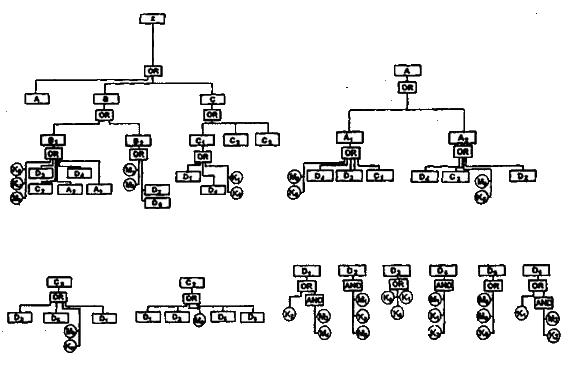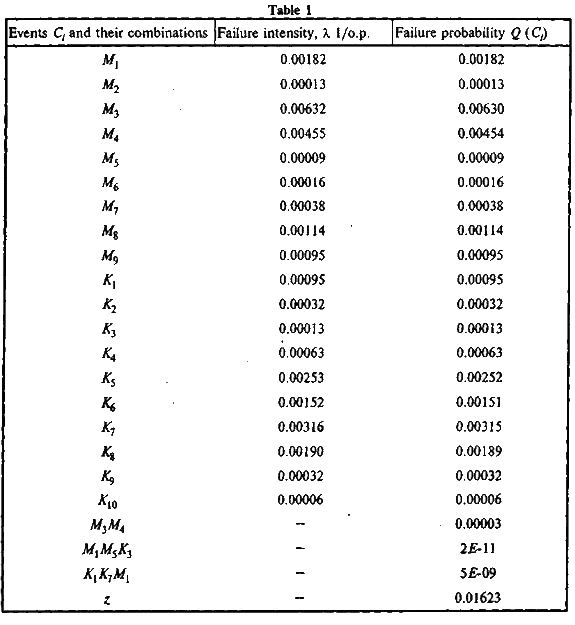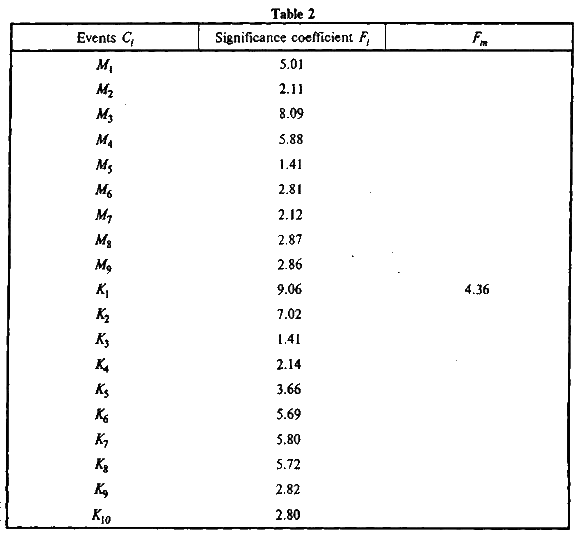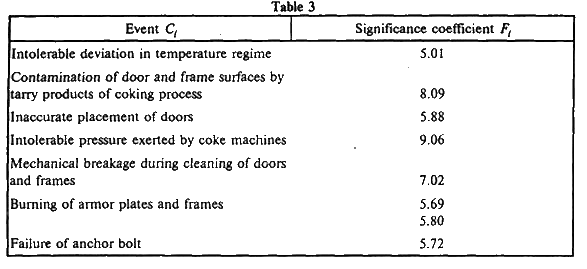Coke and Chemistry, Koks i Khimiya
6, 1998 No. 6, pp. 16-19, 1998
UDC 662.741.3
Analysis of the Reliability of the Elements of the Head Zone of Coke Ovens
A.S. Parfenyuk*, O.E. Alekseeva**, V.S. Karpov**, and P.A. Zakharov**
*Donetsk State Technical University, Ukraine
**Moscow State Academy of Chemical Machine Building
Thereliability of any technical system is determined by the structural and technical characteristics of its elements, operating regime, conditions of exploitation, repair quality and technical servicing.
The elements of the head zone of the division walls of a coke oven (brickwork of the at heating flues, flue-wall armor, frame, doors) are in direct contact and interact with one another. The failure or breakdown of one of these elements may result in an accelerated damage of the remaining ones and may exert a negative effect on coke production and the ecological situation. In the absence of a detailed analysis of the failure process of this system of elements it is difficult to find out the original factors responsible for the low level of reliability of the head zone of division walls of the coke oven and the extent of damage caused and the conditions contributing to it.
In order to analyze its reliability, to develop an efficient system of repairs and to emulate the requirements for improvement and designing, it is necessary to work out a classification of failures of the elements and causes of failures by the degree of their impact on the failure of the zone. Since all causes for failures never act separately, exerting a combined effect, for the analysis of the reliability we used the most effective method for such case — the construction of "failure trees" (FT) with a set-theoretic description in symbols of Boolean algebra. The failure tree makes it possible to locate the weak points of the system, to eke into account all the, relationships of the conditions existing in it, which can cause a failure, to rank the causes of failures and also take account of the mutual effect of the elements.
The failure tree for the head zone of division walls of coke ovens developed during the analysis of various events leading to the failure of the system of the head zone of division walls of coke ovens provided that the anchorage is intact, is given in the figure. The designations and symbols used are as follows.
The final event: z = the shutdown of the coking chamber associated with an emergency state and the impossibility of the exploitation of the head zone of division walls or with the intolerable contamination of the environment.
The main events: A = failure of brickwork; B = failure of flue-wall armor and frames; C = failure of doors.
The intermediate events: A1 — the appearance of a set (more than three) of through cracks and pits; A2 = the formation of troughs and burnouts; B1 = the formation of through cracks and bent fractures; B2 = contraction of the frame, which hinders the pushing of coke; C1 = fracture of the lining; C2 = gas leakage through the door; C3 = the door cannot be replaced again; D1 — the damage of the door sealing; D2 = the slagging of the brickwork surface; D3 = the warping and bending of the flue-wall armor and the door body; D4 = browning of the coking chamber; D5 = failure of door latches; D6 = the upsetting of the geometry of the frame surface.
The starting events: M1 = intolerable deviation of the temperature regime; M2 = the unbending of the frame hook; M3 = the contamination of the surfaces of doors and frames with tarry products of the coking process; M4 = the door is installed incorrectly; M5 = the overheating of the coke block; M6 = the damage of the sealing between the brickwork and the armor; M7 = the high thermal bending of the door; M8 = failure of the nut and screw thread; M9 = failure of the cross bar; K1 = intolerable impact exerted by coke machines; K2 = mechanical damage during the cleaning of doors and frames; K3 = intolerable deviation of the hydraulic regime; K4 = the formation of through fatigue cracks in the door; K5 = unsatisfactory impact of the anchorage on the brickwork; K6 = burning of flue-wall armor and frames; K7 = spreading of the "ends"; K8 = failure of the insertion bolt; K9 = irregular lubricating of the "annular extension of the screw/cross bar" system; K10 = the detachment of the hook.

The failure tree for the head zone of division heating walls of coke ovens.
The failure tree is characterized by the presence of a certain main event z. In the case under consideration this is the shutdown of the coke oven because of the limiting (critical) state of the head zone of the division walls. The effect of the technical condition of the head zone of the division wall on the probability of occurrence of such an event may be represented by a Boolean identity as follows:
 (1)
(1)
Here A, B, C are the failures of the brickwork, armors and frames, and doors, respectively.
The signs of the failures and limiting states of the object are the termination (complete or partial) of the functions of the object; the occurrence of processes that impede the functioning of the object; the termination of the service life [1]. On the basis of the information obtained by the method of expert estimates, the limiting state of the elements of the head zone of division walls of coke ovens has been established. For example, the limiting state for the brickwork is the presence of a set (more than three) of cracks or pits, troughs and burnouts in the division wait of two adjacent heating flues. The failure of the armors is the appearance of deep spallings (> 20 mm) and that of the frames is a deflection of > 50 mm. The limiting state for the doors is the presence of a deflection of > 25 mm (for soft asbestos sealing); > 10 mm (for iron-to-iron sealing) or the spalling of lining bricks (> 50%).
It has been found that the limiting (critical) state of the brickwork is caused by the following events: A1 = the formation of through-the-thickness cracks and A2 = the formation of through burnouts and pockets. From the figure it can be seen that the events A1 and A2 occur under the influence of failures associated with the performance of the brickwork, such as the slagging of the surface D2, the browning the coking chamber D4, etc. The probability of occurrence of events A1 and A2 also contributes to failures associated with the performance of the anchorage (K5), the deformation and warping of frames and armors (D3). The failures C1 (the damage of the door lining) and C3 (the door cannot be replaced) are the starting events for the event C (door failure); the degree of their effect on the state of the brickwork is also significant.
Thus, the event A may be represented in accordance with the laws of Boolean algebra as follows:

The failure of frames and armors B will occurs as. a result of the formation of through cracks and fractures B1 on the elements or the contraction of the frame, which hinders the pushing of coke B2. The occurrence of events B1 and B2 depends, to a greater extent, on the injury of the brickwork (events A1, A2 and M6) and doors (C3 and M7) of the coking chamber and also on the state of the anchorage (K5) and the intensity of buildup of injuries of the armors and frames (M3, K10, D3, D6).
The event B may be represented in the form of an identity:

The event C (failure of doors) will occur in the case of one of the starting events: the injury of the door lining C1, the gas leakage through the doors C2 or the door cannot be replaced C3.
As can be seen from the figure, the event C occurs not only because of the failures associated directly with the performance of the door elements (D1, K1, M7, etc.). A strong impact on the occurrence of this event is exerted by the unsatisfactory state of armors and frames (D3, D6, K10, M2), the failure of latches D5, and frequent browning in the coking chamber D4.
Thus, the event C may be represented as follows:

Finally, using the algorithm of finding the minimal intersections [2], we can describe the failure of the head zone of the division walls of the coke oven as:

 (8)
(8)
For the given failure tree the total number of emergency combinations 18, of which
15, according to formula (8), are combinations of one failure, one is the combinations of two
failures, M3 and M4; two emergency combinations are the combinations of three failures:
- K1 K7 , M1; (2) M1, M5, K3.
The quantitative analysis of the failure tree consists of the elucidation of the starting
(initial) events, which has the strongest effect on the occurrence of the final event z-
The estimation of the events is made from the value of the significance coefficient,
which is the ratio of the total probability occurrence of an fth event C, in all emergency
combinations to the probability of the final event [3]:
[3]:
 (9)
(9)
where k is the total number of emergency combinations in the system; Qj is the probability of occurrence of an emergency combination. The higher the value of the coefficient, the greater the probabilistic contribution of this event to the failure of the system.
Using the generally adopted proposition that the distribution of the probability of occurrence of events obeys an exponential law and that the events are statistically independent, we determine the probability of occurrence of a starting (initial) event Ci, as follows:
 (10)
(10)
where  is the intensity of the occurrence of an ith event; t is the duration of oven-pushing operations.
is the intensity of the occurrence of an ith event; t is the duration of oven-pushing operations.
During the calculations of the intensities, we used, as the basic data, the statistical sampling of the information on failures from the corresponding logbooks and repair plan-schedules, and also the results of the inquiry of the workers of coke sections of the Avdeevka byproduct coke plant.
The probability of the final event z with combinations of the intermediate events according to the "OR" scheme is determined as follows [4]:
 (11)
(11)
where n is the number of starting (initial) events.
For the final event z with combinations of the intermediate events according to "AND" scheme, i.e., for emergency combinations with two and three events,
 (12)
(12)
Table 1 gives the results of calculations of the probability of occurrence of the starting and final events according to formulas (10)—(12) for one coking period — one oven pushing (1 o.p.).

As can be seen, the main danger for the reliability of the head zone comes from emergency combinations of one failure.
The values of the significance coefficients of the events are given in Table 2. Special attention must be paid to failures, the significance coefficients of which exceed a certain mean value Fm defined as follows:
 (13)
(13)

Table 3 presents the sampling of the most unfavorable failures.
A significant increase of the reliability and durability level of the head zone of division walls of coke ovens is possible only when the significant events are completely or partially eliminated. Based on the analysis of the data of Table 2, we may conclude that the traditional structures of the head zone of division walls must be redesigned, primarily with a view to reducing the force impact of coke machines on the elements (events  and
and  ) and increasing the accuracy of installation and precise fitting of doors (events M3 and M4).
) and increasing the accuracy of installation and precise fitting of doors (events M3 and M4).
It is necessary to note that all the estimates given are not rigidly determinate. They have a probabilistic character, making it possible to qualitatively estimate the role of negative factors which affect the state of the elements of the head zone of the division walls of coke ovens and which lead to their failure. Thus, the information obtained will enable the designers and industrial workers to focus their attention on the most important starting (initial) events and to solve the problems for their prevention or reduction of their effect.

References
1. Godyatsky, V.G. and B.D. Kotlyar, Reliability of Machines and Equipment of Coke Plants (in Russian),
Tekhnika, Kiev, 1992.
2. Barlow, N. and F. Proshan, Statistical Theory of Reliability and Tests for Service Life (in Russian), Nauka,
Moscow, 1983.
3. Parfcnyuk, A.S., A.A. Bulatov, N.A. Khromov et al., "Estimation of the effect of mechanisms of coke machines
on the efficiency of production", Koks I Khimiya, no. 2, pp. 28-31, 1990.
4. Dhillon, B. and C. Singh, Engineering Reliability, Wiley, New York, 1981.
Âåðíóòüñÿ ê ñïèñêó ïóáëèêàöèé 





